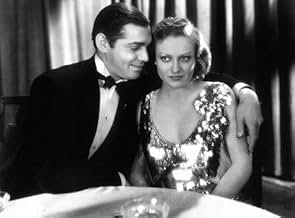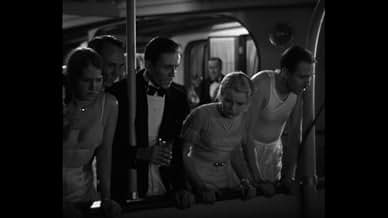After the death of her father and loss of the family fortune, Bonnie (Joan Crawford) gets a job as a cub reporter while her brother (William Bakewell) becomes involved in bootlegging.After the death of her father and loss of the family fortune, Bonnie (Joan Crawford) gets a job as a cub reporter while her brother (William Bakewell) becomes involved in bootlegging.After the death of her father and loss of the family fortune, Bonnie (Joan Crawford) gets a job as a cub reporter while her brother (William Bakewell) becomes involved in bootlegging.
- Awards
- 1 win total
- Wally
- (as Earl Foxe)
- Parker
- (as Purnell B. Pratt)
- Luva's Henchman
- (uncredited)
- Albert
- (uncredited)
- Yacht Waiter
- (uncredited)
- Clinton
- (uncredited)
- Chorus Girl
- (uncredited)
- Reporter
- (uncredited)
Featured reviews
This is a story about a girl who's wealthy father dies leaving her and brother penniless. She finds a job as a reporter and her brother a job as a bootlegger with the mob. Newcomer Clark Gable plays the head of the mob. Trouble happens and kid brother talks then sister comes running to help, though she has to deal with Gable first. This is the movie that put Gable on the map. It would be the first of nine films they would star together at M-G-M.
The storyline is typical but Crawford and Gable made it good. The supporting cast is good as well. This was Lester Vail's first film(though he only made four more). William Bakewell, playing the brother, was funny when he was telling Bonnie to become a runway model and did that strike a pose! Hello!!
I would recommend this film to anyone who wants a glimpse into Crawford's early work.
In fact when Dance Fools Dance came out Crawford was already shooting another film, Laughing Sinners with Neil Hamilton and Johnny Mack Brown as her leads. The reviews Gable got made Louis B. Mayer scrap all the footage that had been shot with Brown and Gable was immediately recast in that picture.
Crawford and William Bakewell play a couple of rich kids whose father William Holden loses everything in the Crash of 29 and dies from the shock of it. And I mean he lost everything as the mansion and its furnishings are auctioned off to pay all the debts the estate owes. Both of them have to go to work, Bakewell not all pleased with that prospect.
Joan goes to work for a newspaper, writing sob sister stuff and she proves she has a knack for it. Bakewell on the other hand gets a job with your friendly bootlegger and his boss who is Clark Gable.
At this point the film makes use of the real life incidents of the St. Valentine's Day Massacre and the murder of reporter Jake Lingle in Chicago who covered the gangland beat. Cliff Edwards who plays the reporter does an excellent job, possibly the best acted part next to Gable.
Playing opposite Crawford as her ever faithful boyfriend from the good old rich days is Broadway actor Lester Vail. I looked Vail up on the Broadway Database and he had considerable stage career. He did not do too many films and truth be told he did not register well as a screen presence. No wonder all the talk was about the few scenes Gable and Crawford had together when she went undercover to investigate the murder of her friend and colleague Edwards.
Though it goes over the top in the melodrama toward the end Dance Fools Dance was a significant milestone in the careers of two screen legends.
The father dies and it turns out he's broke; the picture turns to chapter two, or, How will the spoiled kids survive? –Well, the brother finds work with a bootlegging mob, and Joan gets a job as a cub reporter. (Influential friend of the family helps her out, apparently...no, she's not remotely qualified, but shows a knack for the work right away!) Rather quickly, the brother finds himself over his head in the sordid business of bootlegging...and Joan, eager for a real story instead of the tea parties she's initially assigned to, takes on....you guessed it, the mob.
There's more to it than that, including Joan's sometime boyfriend (Lester Vail), who half-heartedly offers to marry her when her fortune goes kaput and hangs around when she sets off to make her own success; and Cliff Edwards as the veteran reporter who mentors Joan at the paper but hears too much for his own good at a speakeasy.
Clark Gable is riveting as boss gangster Jake Luva; pre-mustache, the swagger is already there. His first scene features a cigarette-lighting routine with girlfriend Natalie Moorhead (excellent in a tiny role as the soon-to-be discarded moll): he blows smoke in her face, she blows out his lighter, and they hold a stare for a lingering shot that speaks more about their characters' relationship than any of their dialog even attempts.
Midway through the story you have a pretty clear idea of where the plot is going to go .but the second half of the picture is still livelier than the first: at least the characters have some purpose in the second half. Crawford is especially good: she is always at the center as the picture revolves through her relationships with the various men in her life—lover, brother, mentor, gangster.
Joan also gets in one good dance—undercover as a chorus girl, she sees her former rich kid friends in the audience and really puts on a number.
No classic as far as plot goes, or dialog but worth seeing for Crawford's performance.
Research question: How would a 1931 movie audience have been impressed by spoiled rich girl Crawford flashing an electric hair dryer?
You can probably guess what I love about Crawford's character. She's a modern woman who looks great out on the dance floor, believes in "trying love out on approval" (a scene which clearly signals pre-marital sex), and would rather work and be independent than settle for the traditional role of wife. Her brother is incredulous, leading to this exchange:
Bonnie (Crawford): "I'm not going to do any of those stupid, silly, conventional things. You'd be surprised what a girl can earn when she sets her mind to it. I'm no dud." Rodney (Bakewell): "You've got the looks, kid. Trade on 'em. Open up a beauty parlor. ..." Bonnie: "That's your idea of me, huh? Beautiful but dumb. All right, I'll show you. I'm going out to get a man-sized job."
That second dance she does when she's working undercover in the gangster's nightclub to get a story is delightful and evokes the flapper era, but to me the feminism in the film is what makes it a solid film, despite its basic plot. Crawford is not known for her on-screen charm, but she summons it here, and does well in the various aspects of her role - society woman, flapper, newspaper reporter, and love interest (hey, the complete woman). Gable is suitably tough as the gang leader, and he and Crawford have great chemistry together. I didn't care for the contrived confrontation which occurs and how the film ends though, which was really unfortunate, and kept it from a higher rating.
Another quote, from Gable to Crawford after her dance: "You got me going, sister." "Can I depend on it?" "In a big way."
Did you know
- Trivia"Dance, Fools, Dance" is clearly based on two infamous incidents in Chicago crime history: the 1929 St. Valentine's Day Massacre in a garage and the June 9, 1930 murder of Chicago Tribune reporter Jake Lingle, who was shot while heading to a train station. However, unlike the movie's Bert Scranton, Lingle was a shady character who played both sides of the law and had parlayed a $65 a week salary into a $60,000 income. In journalistic terms, Lingle was known as a legman who would telephone in the salient details of the story which would be actually written by a rewrite man. This is what happens when Joan Crawford's Bonnie phones in her story after the shootout.
- GoofsWhen in the newsroom Scranton tells Bonnie that if they had a chance they would cut the Lord's Prayer to a one-line squib and he quotes, "Now I lay me down to sleep". But the line is not from the Lord's Prayer, it is actually the first line and title of the bedtime prayer, "Now I Lay Me Down To Sleep".
- Quotes
Bob: You know I'm very much in love with you, don't you?
Bonnie: Are you?
Bob: I'm crazy about you, and you know it.
Bonnie: I didn't know.
Bob: Well, you know it now. What about it?
Bonnie: That's it... what?
Bob: Going to make me stand on ceremony?
Bonnie: You think I'm so old-fashioned?
Bob: I hope not.
Bonnie: You're right. I'm not. I believe in... in trying love out.
Bob: On approval?
Bonnie: Yes, on approval.
[they kiss as the scene fades out]
- ConnectionsEdited into Hollywood: The Dream Factory (1972)
- SoundtracksPiano Sonata No. 14 in C sharp minor, Op. 27 No. 2 'Moonlight'
(1800-01) (uncredited)
Written by Ludwig van Beethoven
Played on piano by Natalie Moorhead
Reprised on piano by Joan Crawford in a swing version
Details
Box office
- Budget
- $234,000 (estimated)
- Runtime1 hour 20 minutes
- Color
- Aspect ratio
- 1.20 : 1
Contribute to this page




































